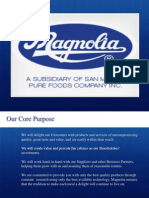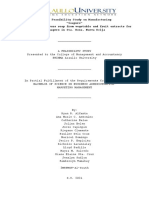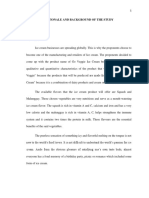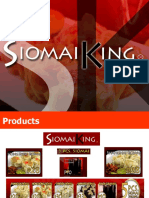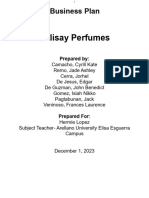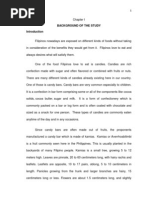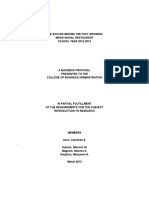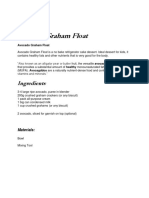Chapter 2 - Fs Market Study
Chapter 2 - Fs Market Study
Uploaded by
Alberto DomingoCopyright:
Available Formats
Chapter 2 - Fs Market Study
Chapter 2 - Fs Market Study
Uploaded by
Alberto DomingoCopyright
Available Formats
Share this document
Did you find this document useful?
Is this content inappropriate?
Copyright:
Available Formats
Chapter 2 - Fs Market Study
Chapter 2 - Fs Market Study
Uploaded by
Alberto DomingoCopyright:
Available Formats
FEASIBILITY STUDY RESULTS 2.0 MARKET STUDY 2.1 2.1.
1 Market Study of Ilang-ilang Essential Oil The Product and Product Description
21
The proposed project shall produce: (a) essential oil from ilang-ilang flowers and, (b) ilang-ilang cut flowers.
Ilangilang essential oil
It is a clear, colorless to pale yellow extract from the flowers of ilang-ilang. It has a strong aromatic flowery scent which makes it a base ingredient of majority of perfumery products. Like Jasmine, it can be mixed and it disperses easily with tonka bean, sandalwood, orange, and neroli.
Ilang-ilang essential oil can be commercially extracted through steam distillation from the ilang-ilang flowers. This accounts for approximately 1 to 2.5 % of the total weight of matured flowers depending upon the maturity of the flowers, time of the day, climate during its harvest, and firmness of the petals of the flowers.
The oil has the following physical and chemical characteristics: Linalol (32 %) 112 154.90 0.929 - 0.952 1.4835 - 1.4940 10.75 45 soluble in the proportion of 2 oil:1 ethyl alcohol (80-90 % by volume) Farnesol Linalylacetate Cardinen Salicylate Benzoate A-pinen Cresol and Linalylbenzoate Caryophyllen Nerol Cresylmethylether
Main chemical content Ester Number Specific gravity at 300C Refractive index at 300C Specific rotation Solubility Other chemical components Geraniol Methyl Safrol Isoengenol Eugenol
Ilang-ilang essential oil comes in three grades: First fraction taken mainly from the first 2 hours of distillation.
MARKET STUDY
FEASIBILITY STUDY RESULTS
22
This is the highest grade form that contains primarily esters in the form of linalool and aldehydes - the chemical component that embodies the scent of the flower.
Second fraction taken from the second 2 hours of distillation. Third fraction taken from the last two hours of distillation. Uses of Ilang-ilang Essential Oil
Used as a material for the manufacture of perfume. As a high grade essential oil, it is one of the most expensive oil used as a base perfume/ingredient of high grade perfume. Its excellent staying power holds the fragrance of perfume to stay longer while its floral sweetness makes it useful as a modifier in feminine perfumes. An example of perfume mixture is exotic fragrance. Add the blend of essential oils listed below to ten milliliters of 100 proof vodka for perfumes and colognes. Oils can also be diluted in vegetable oil. 12 3 2 1 Drops Drops Drops Drops Patchouli Geranium Ilang ilang Cinnamon leaf or cinnamon bark,(Cassia)
As antidepressant. It is used to stimulate the center of the brain to release endorphins, thereby reducing pain as well as increasing euphoric and erotic moods. This is beneficial for nervous depression that is accompanied by severe tension. These properties allow dissolution of external as well as internal tensions with additional euphoric effects. Ilangilang helps reconcile feelings of anger, rage and frustration, by replacing them with joy, sensuality, euphoria, inner trust, and peacefulness (Anao ilang-ilang essential oils literature).
As medicine. It is effective in nervous exhaustion and blockage in the heart region. It helps in lowering blood pressure and creates more rhythmic breathing. It is used both as antiseptic and antipyretic in the form of body oil.
MARKET STUDY
FEASIBILITY STUDY RESULTS
23
Other countries use it as a substitute of quinine to fight malaria. Others use it to control epilepsy. Cosmetic uses. It is used for the manufacture of cologne, lotion, hair conditioner, cosmetics and hot oil cream (second grade essential oil). As a bath or massage, the oil properties penetrate the skin, there by increasing circulation. As a hair growth stimulant and for treating split ends. It is found to be effective when applied before shampooing. When added to skin lotions, it rejuvenates, softens and smoothens the skin. This is found to be an effect of the plant hormones present in the oil. Examples include: Lovers Massage
Mix two to three drops of the following blend per teaspoon of a vegetable oil base such as sweet almond, avocado or grape seed. 1 4 5 Drop Drops Drops Ilang-ilang oil oil Rose Sandalwood 1 1 drop Ilang ilang oil drop Potchouli or vetiver
Before Bed Bath A warm relaxing soak in a fragrant bath can ease the cares of the day and soothe tense muscles. Dilute four to eight drops of the following blend in two teaspoons of vegetable oil or liquid bath soap. Add to bath water and mix well. 3 2 2
Drops Drops Drops
Lavender Ilang-ilang Grapefruit
Used for the production of soap, candles, personal care products, talc and detergent powder (third fraction).
In aromatherapy, it has the same effects as when used as anti depressant. These are widely used in India, Japan and the United States basically for healing, pleasure, and stress reduction. It has the extra ordinary ability to relax facial muscles and in removing headaches from tension. For aromatherapy examples of mixtures are as follows:
Mix 6 drops of this blend with one ounce of water and diffuses the mixture in an aromatherapy lamp. 15 Drops Ilang-ilang oil
MARKET STUDY
FEASIBILITY STUDY RESULTS
24
45 Drops Mandarin oil 40 Drops Bergamot oil Mix a few drops of this blend to an aromatherapy lamp to ease mental fatigue.
8 drops Ilang-ilang oil 8 drops Lemon 8 drops Basil 8 drops Basil Production of decorative materials (potpourri) and air fresheners like the Exotic Island Potpourri.
Mix the following in a covered bottle. Keep it covered for three weeks, shaking the contents periodically to distribute the aroma. Display the potpourri in a decorative container. Sprinkle on more essential oils to renew the fragrance as needed. 1 1 1 1 Cup Cup Cup Cup Dried orange or lemon peel Bay leaves Whole allspice Cinnamon sticks 20 20 15 4 drops drops drops drops Ilang ilang oil Mandarin oil Cinnamon oil Vetiver oil
As natural air fresheners for buses, cars, houses and offices.
2.1.2
Product Concept Ilang-ilang embody clean and good quality environment. It signifies natural beauty and good for the health.
This will be emphasized by the fresh and scented air it will create in the municipality and to passers-by who traverse the national highway from Manila to the Cagayan Valley. This will serve as a natural way of promoting the products ilang-ilang oil and fresh flowers.
Competitive Condition Ilang-ilang as an essential oil is not new in the industry. It is a very important ingredient of perfume products, soap and other health care products.
The ilang-ilang essential oil market meets competition in the suppliers level for raw materials (ilang-ilang blooms) and in the production of essential oil itself.
MARKET STUDY
FEASIBILITY STUDY RESULTS
25
The suppliers market for ilang-ilang blooms is at present very small, sparsely and widely distributed hence, impractical to exploit. Its maturity as a market will pose a little competition three years from now. With the existing extractors in the country and the versatility of these machines for conversion to the extraction of other essential oil plants, competition for the supply of flowers will increase. The ilang-ilang trees planted in Isabela, approximately 15 hectares and Tarlac approximately 3 hectares will encourage the establishment of extraction plants. These extractors will not only pose competition for the supply of raw materials but also for competition for the market of essential oil.
In the market of essential oil, the greatest source of competition is the synthetic oil (Table 10).
There are a wide range of natural and synthetic materials that are used in the same product where ilang-ilang essential oil is used as raw material. Linalool, the main component (32%) of ilang-ilang essential oil can be found in many natural forms, namely: Clary sage, Thyme, Bergamot, Niroli, Lavender 40 & 42, Lavandin, Coriander, and Rosewood. All of these are now naturally cultivated plants and are usually produced as spices but are now being tried in large scale production. This is because essential oil as an industry in the Philippines is still young and at its growth stage. The international market is growing. The desire of the world population to go natural will shift the demand for inorganic oil to organic based products. Traditional products are now facing stiff competition from imported products that are priced lower than local products, forcing the agricultural industry to look for more profitable and alternative crops.
Its synthetic counterparts are now produced in the Philippines.
Table 10. Synthetic And Natural Materials Of Essential Oil
Class Naturals Labdanum extract Cedrember Iso E Super Ambroxan ANIMALIC (see also Amber and Musk) Civet Castoreum Indol Leather Floral Jasmin Synthetic (Ingredients) Class Resinuos Woody Woody Woody Cedarwood Patchouli Dry wood Fecal Class/ Specific character
MARKET STUDY
FEASIBILITY STUDY RESULTS
Paracresol Phenylacetic acid Floral Floral Narcisse Honey
26
. Table 10. Continued . .
Class Naturals Synthetic (Ingredients) Class Class/ Specific character Hair Sweaty
ANISIC
BALSAMIC
Costus Cumin Basil, Estragon Armoise Clary sage,Roman Cvhamomile Benzoim siam Peru balsam oil Styrax oil
Iris Spicy Methyl chavicol (Thuione) Camphor Linalool Resinous Sweet Cinnamic Salicylate Spicy Lavander Lavander Spice Spice Floral Balsamic Hexyl cinnamic, aldehyde, Amyl cinnamic aldehyde Citral (terpineol) (linalool,L.acetate) (citral) Citronellal geranyl nitrile anisaldehyde benzaldehyde Eugenol isoeugenol styrallyl acetate Phenyl acetaldehyde, Phenyl acetaldehyde dimethyl Acetal ethyl phenyl acetate Floral fruity fruity fruity fresh aldehydic aldehydic
CINNAMIC
Cardamon Lavandine Rosemary Cinammon Bark Cinammon Leaf
(Vanillin) (Vanillin) (Phenylpropyl alcohol), Cinnamic alcohol, Phenylpropyl alcohol, Methyl cinnamate , Benzyl salicylate (Camphor) (Camphor,Cineol) (Camphor,Cineol) (Cinnamic aldehyde) (Eugenol) Cinnamic ,Alcohol ,Phenyl propyl alcohol,Methyl cinnamate
Sweet
Floral Floral Seed Linalool Eucalyptus
Balsamic
Styrax oil
Jasmin lemon fresh fresh linalool citronella lemon lilac almond clove
CITRUS
Lemon Lime distilled Sweet orange,Mandarin Bergamot Lemongrass
FLORAL ALMOND BLOSSOM CARNATION GARDENIA HYACINTH HONEY
spicy fresh green green
rose lilac rose rose fresh
JASMIN
jasmin absolute
phenylacetic acid benzyl acetate hedione,jasmal,amyl cinnamic aldehyde hexyl cinnamic aldehyde Indol
animalic
Ylang extract
cinnamic cinnamic animalic linalool
muguet
MARKET STUDY
FEASIBILITY STUDY RESULTS
LILAC Terpineol anisaldehyde household almond Class/ Specific character
27
floral
Table 10. Continued . . . .
Class Naturals Synthetic (Ingredients) heliotropin acetophenone phenylethyl alcohol citronellol,citonellyl acetate, geraniol,, phenylethyl acetate,P.E, dimethyl carbinol phenoxyethyl isobutyrate,beta-damascone phenylethyl phenyl acetate,rosatol Geranium geranyl acetate, geranyl formate Rose oxide diphenyl oxide amyl salicylate benzyl salicylate cis-3-hexenyl salicylate,hexyl salicylate TUBERO SE Tuberose absolute aurantiol methyl octine carbonate lonone alpha,methy ionone heliotopin ILANG YLANG FLORAL RESH Ilang extra methyl benzoate Neroli linalool benzyl acetate cytronellyl acetate FLORAL geranyl acetate phenylethyl acetate styrallyl acetate cinnamic alcohol BALSAM IC FRESH Bergamot Petitgrain phenylpropyl alcohol benzyl salicylate (linalyl acetate) (linalyl acetate) linalyl acetate isobornyl acetate dihydromyrcenol vertenex (PTBCHA) FRUITY citrus oils aldehyde c14 aldehyde c16 aldehyde c18 gamma-decalactone beta-damascone tuberose tuberose rose pine linalool woody Peach Strawberry Coconut Peach Apple orange blossom linalool jasmin rose rose rose gardenia woody muguet geranium fruity rhubarb minty fresh green metallic Class sweet
MIMOSA ROSE
Mimosa absolute rose absolute Rose oil
fresh Fruity
raspberry
honey
TRIFLE (salicylate)
balsamic green
green iris iris sweet Lilac
iris concrete
trefle citrus linalool eau de cologne
MARKET STUDY
FEASIBILITY STUDY RESULTS
Tagete allyl cyclohexyl propionate Pineapple Class/ Specific character Pineapple Mirabelle Raspberry Sweet
28
Table 10. Continued . . . .
Class Naturals Synthetic (Ingredients) isogalbanate phenoxyethyl isobuterate helional frambinone cashmeran IRIS iris concrete lonone alpha methyl iononee vertenex (PTBCHA) Costus LAVEND ER lavender 40/42 Lavandin Rosemary LEATHE R Castoreum birch tar Labdanum Cistus isobutyl quinoline LINALOO L Bergamot clary sage Coriander Lavender Lavandin Rosewood Ilang MINTY Peppermint geranium bourbon Oakmoss evernyl MUSK galaxolide musk T tonalid musk ketone cyclopentadecanolide ambrette seed PATCHO ULI PINE (ambrettolide) cashmeran Patchouli isobornyl acetate fresh seed sweet Fruity Pepper (linalyl acetate) (linalyl acetate) (terpineol) (benzyl acetate) linalool Dihydromyrcenol (linalyl acetate) fresh fresh citrus aromatic spicy lavender camphor woody floral Seed amber amber Earthy Woody Fresh (linalool,linalyl acetate) (linalool,linalyl acetate) Class green rose watermelon sweet musk violet violet violet woody animalic Woody Fresh
camphor camphor animalic Smoky Eucalyptus
rose Algal Dusty
MOSSY
MARKET STUDY
FEASIBILITY STUDY RESULTS
Table 10. Continued . . . .
Class Naturals Synthetic (Ingredients) aldehyde c12 mna RESINS benzoin siam olibanum extract Opoponax extract Labdanum extract Peru balsam oil SEEDS Ambrette Cardamon Celery Coriander Cumin SPICY Pepper Cinnamon bark Cinnamon leaf eugenol clove bud pimento berry Bay Nutmeg Pepper Cardamon Coriander Cumin SWEET (powdery) vanilla absolute benzoin siam peru balsam oil Tonka (vanillin) ethyl vanillin (vanillin) (vanillin) coumarin (coumarin) heliotropin frambinone cashmeran ,helional violet leaf absolute mimosa absolute cedarwood verginian green floral cedryl acetate Vertofix cedramber Guaiacwood Rosewood (linalool) linalool amber Smoky Pencils lilac fruity musk Fruity Marine Violet balsamic balsamic Hay camphor linalool seed Terpenic Terpenic Seed Seed Sweaty (eugenol) (eugenol) carnation (cinnamic aldehyde) linalool spice spice Class aldehydic sweet Balsamic Insence Class/ Specific character
29
amber sweet musk spice
Leather Balsamic Camphor Terpenic Spice Animalic Terpenic
Table 10. Continued . . . .
MARKET STUDY
FEASIBILITY STUDY RESULTS
Class/ Specific character
30
Class
Naturals sandalwood E.I vertyver bourbon
Synthetic (Ingredients) sandela brahmanol iso E super cedramber,ambroxan methyl ionone vertenex (PTBCHA)
Class
Musk,earthy dry wood violet fresh
WOODY AMBER WOODY IRIS
vertyverly acetate
Ilang-ilang essential oil in the form of linalool is specifically classified as fresh, a characteristics possessed by other natural and synthetic oils derived form Citrus, Bergamot, Jasmin, Methyl napthyl ketone, Rose, Geranium Tuberose,Iris, Vertenex (PTBCHA), Linalyl Acetate, Clary sage, Thyme, Niroli, Lavender 40 & 42, Lavandin, Coriander, and Rosewood. Almost 90 % of oils of all types are imported. The main source of ilang-ilang oil in the world is Reunion Island, Madagascar, and the Comoro Islands.
According to the recent conference on essential oil production among producers, the market of essential oil is large and satisfied through importation and most of these are synthetic in nature.
The Philippines exported at least $7,150.00 worth essential oil in 2000 in the form of naturally produced essential oil. Most of the producers of essential oil is composed of oil from citronella. This is brought about by the lack of supply of ilang-ilang and the cheaper cost of extraction of citronella as claimed by Mr. Khong Hon, one of the producers of citronella oil in Isabela. Mr kong Hon claimed, the government through the Department of Science and Technology distributed 50,000 trees in Isabela in 1998 and most of the takers were landed and 75% of which were planted as fence. One of the producers of ilang-ilang oil in commercial scale is the Anao Multipurpose Cooperative Incorporated. It produces at least two liters per week in 6 months during the peak months of production of ilang-ilang.
It supplies this to Agers Essence and to a local producer of cologne, lotion and soap in Anao.
MARKET STUDY
FEASIBILITY STUDY RESULTS
31
The underutilization of the extractor of the Anao Multipurpose Cooperative Inc is brought about by the lack of flower bearing ilang-ilang trees. They started with a 25 capacity plant and expanded into a 50 and now have a 100 capacity extractor.
The shift in the use of synthetic chemicals as sources of essential oil, scents is an indicator of the growing demand for fragrance oil. Further, for use in laundry soap and in aromatherapy, synthetic sources can be produced in the laboratories at a cheaper price, P200.00 to P250.00 per liter on wholesale price for imported essences. Naturally produced essential oils like Citronella command higher price of P1,000.00. As claimed by Mr. Kong Hon, a toiletries producer our naturally produced essential oil cannot compete with imported essences because, the production cost ranges from P450.00 to P500.00 per liter. In the industry/manufacturers conference, it was pinpointed that better technology will reduce the risks from stiff competition to a profitable level. This is expected to happen given the support of the Department of Science and Technology in terms of research and development
On the other hand, it is forecasted that there will be a shift in the use of organicbased essential oils due to increasing demand for nature-based health food, vitamins, cosmetics, perfumes soaps and in aromatherapy.
With organized producers led by no other than an officer of the United Laboratories Inc., one of the largest users of essential oil, the market of essential oil shall grow.
Organic-based essential oils shall become available at affordable price to the market.
New technologies designed to make extraction more efficient shall make organized groups more efficient given an assured supply of fresh flowers from its members. The above condition places the project at advantage because of its vast lands suited for the production of ilang-ilang and its nearness to Manila, the location of users of essential oil.
MARKET STUDY
FEASIBILITY STUDY RESULTS
32
Carranglan is very accessible and communication facilities are readily available. Electronic Communication shall facilitate its access to buyers.
Other producers like Anao supplies barely 0.01 % of the market of ilang-ilang essential oil of Manila.
A Cebu-based processor of Citronella (cooperative) supplies only 5% or 100 liters of Citronella oil needs of Cebu, 2,000 liters per month.
Another source of demand for ilang-ilang is fresh flowers for the production of leis or garlands.
These are usually sewn in leis in combination with sampaguita. These can utilize the harvested immature flowers of ilang-ilang. Competition in this level is posed by backyard producers. The presence of sampaguita as one of the products of the municipality will provide a complimentary advantage of ilang-ilang cut flowers over the small producers. 2.1.3 Product Pricing
The present price per liter of ilang-ilang essential oil is P10,000.00. This shall be the selling price of the product. This is assumed inclusive of the flowers fraction level. The price is expected to increase inspite of the expected increase in production.
This will be brought about by improvements in the efficiency of production supported in research and development by the Department of Science and Technology and market development by the Department of Trade and Industry. The increase in the supply of ilang-ilang flowers is too minimal that any increase in production of ilang-ilang essential oil will not significantly affect its price. If there will be changes in the price of ilang-ilang essential oil it will occur in its 10th year when trees reach their full flowering stage where growth of the industry is just starting.
The increase in the production will be determined by the maturity period of ilang- ilang trees, area planted to ilang-ilang, increasing health consciousness of the
MARKET STUDY
FEASIBILITY STUDY RESULTS
33
buying public (preference for naturally produced products) and external sources of imported oil. 2.1.4
Current Marketing System
Sources of Essential Oil (Figure 5) There are two sources of ilang-ilang essential oil namely: local production and importation..
Local Production Anao Multipurpose Cooperative Inc. It is the only processor of ilang-ilang in Luzon. It has its own extractor, a 100kg output capacity. It produces its own ilang-ilang raw materials.
Currently, there are small processors of essential oil and majority of the producers process Citronella.
It is a cheaper source of essential oil for detergents, soap, perfumery, and for pharmaceuticals. There are indications however that the processors of Citronella will be diversifying into the processing of ilang ilang in the future when the ilang ilang plantation have matured. Local production of ilang ilang essences is limited by the availability of blooms for processing. Ilang ilang is mostly planted as fences. It is only in the suburbs that ilang ilang gained economic importance as a source of livelihood. Those who planted ilang ilang other than in Laguna and Bulacan planted it as ornamental plant. The flowers bring feelings of relaxation to the households. Importation
The largest producers of ilang ilang essential oil are the Reunion Island, Madagascar and Camorros.
MARKET STUDY
FEASIBILITY STUDY RESULTS
34
Madagascar is a new entrant in the market. In fact one of the processors used came from a local fabricator in the Philippines (Nagcarlan, Laguna). Other essential oils are produced by cold countries in green houses and these are usually herbal plants. Market Outlets Local Producers
2.1.6
The Anao Multipurpose Cooperative, Inc sells its products to one of the perfume makers in the locality and signified that their supply of oil is inadequate. The processors produce their own ilang-ilang. These are sold directly to the perfume and cosmetic producers. It has not reached the export market yet because its quantity is too uneconomical for marketing. Bulacan and Laguna sell the flowers to the garland makers.
In Laguna, the Association sells their flowers to the manunuhogs during ordinary days and to an assembler during Sundays. In Bulacan, producers sell it to the manunuhog or garland makers. These are usually used immediately for it easily discolors when wet, hence, it cannot be mixed with ice-packed sampaguita garlands. Importers
Manufacturers serve as intermediaries of users. This is because essential oils are used in small quantities. Buy from producers and importers to reduce cost. Further, it can be deduced that e-commerce made it easier for manufacturers to get hold of these products.
MARKET STUDY
FEASIBILITY STUDY RESULTS
35
Local producer of essential oil
Importer of essential oil
Wholesalerretailer
Perfumery
Cosmetics
Aromatherapy
Pharmaceutical Products
Health Clinics
Figure 5. Current Marketing System of Essential Oil
Ilang-ilang essential oil is normally sold to perfume makers (fragrances), cosmetics and toiletries (toothpaste, mouthwash, cosmetics), food and confectioneries (confectionery flavoring, chewing gum, food flavoring), aromatherapy, pharmaceuticals and health clinics (cough/cold remedies and industries (industrial solvents, fragrance for cleaning products, tobacco). These are directly sold to manufacturers and users. At present, users of natural essences use synthetic oil due to inadequate supply and the high price of naturally produced essences. The high price of natural essences is brought about by the lack of adequate flowers to process. These are usually small in sizes, and widely and sporadically distributed that its collection for processing is uneconomical. Processing of essential oil requires fresh and matured flowers for maximum recovery rate at the best quality.
MARKET STUDY
FEASIBILITY STUDY RESULTS
2.1.7
36
Supply and Demand Analysis
The project shall satisfy 44.28 % of the local demand of the companies interviewed are using essential oil (Table 11).
Table 11. Demand of Ilang-Ilang Essential Oil By Some Firms
TYPE/FIRM A. MANUFACTURERS Agers Essence Asia Brewery Inc. Avon Bath Origin Bush Boake Allen Phils., Inc California Mfg. Co., Inc. Colgate Palmolive Phils. CRD Herbal Products Essential Mfg. Euro Chemicals Inc. Goldware Mfg. Corp. Goldwin Mfg. Lab. Inc. Helios Mfg. Corp. Intl Pharmacuticals Inc. Jhonson & Jhonson Phils. Kimberly-Clark Phils. Inc. Lamoiyan Corp. Organix Concepts Corp. Proctor & Gamble Phils. Royal Indstrial & devt. Corp. Small Soap Producers Swiss Pharma Res.Lab.Inc. Uniliver Phils. United Laboratories Inc. Universla Robina Corp. Veraluz Intl. Corp. Pureskin Intl. Abbott Lab Wechem Manufacturing Lam Ar Coml & Candle Factory Bayer Belman Laboratory Redisol Inc. Sub-Total Aromatheraphy Centers Drus-Alt. Health Care and Nut. Ssup. & Dist. Center Body shop The Aromatheraphy Centers Bioessence Aabegail de amor Lucky Princess New day Spazen Aromatheraphy Sunrise Massage Service corp. Health Care Service Corp. Sub-Total Grand Total AVERAGE REQUIREMENT PER PRODUCTION (Liters) 2 15 2 4 4 15 7.5 4 4 13 15 6 15 15 5 13 8 15 5 15 15 5 15 15 5 15 12 5 8 15 5 297.5 10 7.5 5 3 2 3 5 2 2 39.5 337 15 10 6 4 6 5 6 6 78 418 TOTAL REQUIREMENT PER YEAR (Liters) 8 15 8 4 4 15 30 4 4 13 15 6 15 15 5 13 8 15 5 15 15 8 15 12 5 8 15 12 5 8 15 5 340 20
Other companies in other parts in the country like Cebu, Angeles and Santiago indicates a growing demand for essential oil Approximately large cities have one large soap producer and small ones including large provinces that have at
MARKET STUDY
FEASIBILITY STUDY RESULTS
37
least two small scale producers. Perfumeries in small scale exist in cities and provinces with at least one small scale producer.
The market of essential oil will grow given the increasing population. Every baby born will need soap, cologne, alcohol, perfumed diapers and pampers, softeners, and perfumes. The Department of Science and Technology, Department of Trade and Industry, Local Government Units, and state universities continuously train small and medium producers of soap and toiletries. This would mean an increase in the demand for essential oil.
There are only three large exporting countries of ilang-ilang essential oil Reunion Island, Comoros and Madagascar (Table 12). The imports and exports of essential oil showed increasing trend in world exports and imports of essential oil (Table 13). The major importers of essential oil are the United States and European. Developed countries are the main importers of essential oils, with the EU and the US accounting for 44 per cent and 8 per cent respectively in 1998 (UN 1999).
Table 12. United States Imports Of Ilang-Ilang Essential Oils By Country Of Origin
COMMODITY AND ORIGIN
COMOROS FRANCE INDONESIA JAPAN MADAGASCAR SWITZERLAND UNITED KINGDOM OTHER TOTAL
1999 kilograms 547 37,252 555 185 0 405 1,613 280 40,837
1999 dollars 47,130 2,036,620 14,389 24,687 0 25,480 72,637 15,531 2,236,474
2000 kilograms 3,115 38,811 820 24 400 580 720 3,524 47,994
2000 Dollars 180,868 1,864,571 27,427 25,980 23,422 43,304 39,363 62,926 2,268,861
Table 13. World Trade In Essential Oils, Perfumes And Flavours in US $ (millions) SOURCES EXPORTS MARKET STUDY 1986 2 149 1990 4 122 1994 5 051 1998 198698 7 435 10.9%pa
FEASIBILITY STUDY RESULTS IMPORTS 2 008 4 206 4 802
38
6 811 10.7%pa
Source: United Nations International Trade Yearbook 1999 and 1992.
Compared to the exports for essential oil of large countries like the United States in 2000, the Philippines will only share .4%. With growing demand for organic based essences and clean environment, the demand for essential oil of ilang-ilang will grow. With the support of research and development efforts of the DOST, there will be improvements in the quality of oil production in the future. Cost of production will then become lower hence will enhance its competitive edge in the local and international market. The climatic requirement of the plant and vast land area available for planting in the Philippines will be a competitive edge of the Philippines to current producers of essential oil. Marketing Plan Product Name The suggested name of the product is PRISTINE Essential Oil. This will embody the picture of a clean barangay producing clean products out of clean and pure products of nature.
2.1.5
2.1.6
Pricing of Ilang-ilang Essential oil
The market price of P10,000.00 is acceptable and highly profitable for the organization. This, however, have to be reduced to conform to the world market price when the organization. decides to enter the export market.
At present the price of any kind of essential oil in the world market is ranging from P2,500.00 to P53,000.00 per liter.
2.1.7
Distribution, Intermediaries and Promotion The organization. shall take charge of distributing the essential oil products. Several strategies should be undertaken:
MARKET STUDY
FEASIBILITY STUDY RESULTS
39
Introduction of the products must be done in small companies to ensure strengthening of relationship and building of reliability of the organization..as a supplier. The initial distribution will be very costly to undertake initially but several considerations points out that the organization. can cope up with it. It should build its reliability as a supplier in terms of timeliness, adequacy of production and sustainability of quality of products. The pharmaceuticals and soap producers are adequate markets. The requirement of these companies is the reliability of supply and low price. It is therefore necessary that members undertake the establishment of plantations with those planted along thorough fares as buffer supply. Management of the plantations is necessary to assure supply of flowers.
Technological capability building of the organization. to undertake the project and improve the quality of its product must be undertaken. To improve and strengthen the capability of the organization. in this project, they should request:
Technology and Livelihood Center or CITEM to undertake training on the packaging of the product, production of toiletries, soap and perfume. Although it is not recommended that they diversify into these lines of products, these will encourage some members to undertake these endeavors. It will also give the organization. a better picture of the industry.
It is recommended that the organization. concentrate on the local market while perfecting the technology and acquiring adequate knowledge of the market. The export market for ilang-ilang essential oil is large and can be reached electronically but is more discriminating in terms of quality.
Electronic gadgets can be used to reach market outlets and ensure the arrival of the products on time.
Payments can be done through the banks. This strategy will however be effective for large companies with reliable contacts.
MARKET STUDY
FEASIBILITY STUDY RESULTS
40
Membership in the Essential Oil Society of the Philippines. Contacts can be initially established here while literature on possible technologies and marketing strategies can be acquired in the groups activities. The members of this group are pharmaceutical companies, aromatherapy, cosmetic producers and toiletries. This association is usually supported by the Department of Trade and Industry and the Department of Science and Technology.
Promotion can be undertaken through the support of the Department of Trade and Industry, Local Government Unit of Carranglan and the Department of Agriculture.
The Department of Agriculture can help push for the popularization of the product by conducting industrial fora, The product will promote itself given the limited oil available in the market.
Research and development must be undertaken with state universities and colleges around the area.
This can be considered as high value crop, but it will take a lot of time before its economic importance will be recognized. The participation of producers in trade fairs will pave the way for its recognition as an economic product.
2.2. 2.2.1
Market Study of Sampaguita Blooms (Flowers) and Garlands Product and Product Description
Sampaguita bloom is a white, 5 to 7 petalled sweet-scented flower with hollow peduncles. It is made into garlands as pure sampaguita and in combination with ilang- ilang and Champaca.
It maintains its fragrance at a minimum of one day at normal temperature, 2 days at 20oC to a maximum of 6 days at 5oC and 4 days storage life at 10oC.
It has sweet aroma and can be processed into essential oil but it requires costly method of extraction.
Sampaguita as a garland is made up of 2 to 4 leis with 4 to 10
blooms per lei. MARKET STUDY
FEASIBILITY STUDY RESULTS
41
These are tied up together with a string made up of abaca string.
At its center is either a piece of Champaca, three pieces of Camia or ilangilang flowers.
Uses Of Sampaguita Blooms It is made into garlands in combination with ilang-ilang, camia and champaca. It is used as natural air fresheners in business establishments. cars, houses, rooms and in
As a common offering among Catholics, it is used as garlands for the Lord, and saints placed in religious images, It is the source of one of the most expensive essential oils requiring more sophisticated extraction than ilang-ilang oil. As a medicine, it is commonly used as anti-diuretic and anti-pyretic in far-flung barangays. Competitive Condition
The producers of sampaguita garlands are small producers in Laguna (San Pedro, Calamba, and Sta Cruz), Bulacan, Pampanga, and Isabela (Santiago City). All of the above producers sell their produce to Metro Manila, Bulacan, and other outlying like Santiago City.
According to DENR, Metro Manila shares the largest volume of demand. Farmers in Laguna and Bulacan testify that Baclaran and Quiapo are their biggest market. A garland maker can sell 10 liters or 10,000 leis a day in any of the two markets.
The estimated production of the sampaguita producers in San Pedro, Laguna is at least 70 liters of buds daily during peak season.
A Metro Manila buyer buys the sampaguita blooms during Sundays.
MARKET STUDY
FEASIBILITY STUDY RESULTS
42
Their products in ordinary days are bought by the manunuhog (garland makers).
For Sta. Cruz farmers, their production level goes as high as 180 liters of buds per day during peak season but goes down to 50 liters during rainy season. Santiago City producers on the other hand, supply buds as far as Bulacan which are in turn sold as garlands in Manila. Carranglan presents an advantage over the other producing provinces due to its proximity and accessibility to other urban provinces and Metro Manila aside from its vast underutilized lands. Being a rolling area, water logging will not be a problem. The competition posed by Bulacan, and Laguna producers is reduced by the land use competition between sampaguita production and housing.
o o
This is a natural effect of the growing urbanization of CALABARZON. In Bulacan, flooding reduced the land devoted to sampaguita. Sampaguita do not thrive well in water-logged areas. Product Pricing
2.2.3
Sampaguita shall be sold by the members to the community-based associations at P30.00 per liter (the current market price). The cooperative shall make garlands out of the buds and sell these at P8.00 per garland on wholesale following the current pricing system. 2.2.2
Current Marketing System
Sampaguita flowers are generally sold by the magsasampaguita (producers) in liters to three types of buyers: wholesalers, assemblers and Manunuhog (garland makers) The wholesalers and assemblers sell the flowers to the manunuhog in large volumes.
Normally, the first two types of buyers exist when the supply of flowers for garland is very low.
They claimed that they have competitive edge over buyers outside the barangay:
MARKET STUDY
FEASIBILITY STUDY RESULTS
43
first, they have access to some owners who sell their products in advance, second, they have the time to buy in small volumes, and third, they lend cash to the magsasampaguita in times of need.
The wholesaler-retailers from Manila buy from the assembler at a price higher by 50 cents per garland. The garlands are distributed by the garland makers to wholesalerretailers and retailers in the morning at a sharing percentage of 70:30.
Seventy percent of the gross sales go back to the garland makers in the following morning.
This system of payment is only applicable during the peak months and to chosen retailers whose trust has been built between the garland maker and the retailer. Utmost, it takes at least six months of sustained 100% repayment. Both directly sell to the consumers through hired sellers while the former redistributes some of the garlands to small retailers (50 to 100 garlands a day).
Some of the retailers, at least one in every distribution point, sell the garlands at a higher price to some retailers. Normally, this is higher by 25 to 30 cents per garland. The higher price normally exists in busy churches like Quiapo and Baclaran.
In Laguna, sampaguita is used to adorn wedding ceremonies in churches, and in making bridal bouquets. Sampaguita to the bride indicates virginity. In Santiago City, a garland maker buys the sampaguita from the farm, makes them into garlands and sells these to retailers. Others are sold by the garland makers directly to consumers specifically establishments, cars and market vendors.
Bulacan garland makers get their supply in Isabela during rainy season. These are bought by a wholesaler that sends these to Bulacan through the
bus.
Thru cell phones, the wholesaler informs the garland maker in Bulacan the time the product has been loaded in the bus, the bus company and the driver who received the product. MARKET STUDY
FEASIBILITY STUDY RESULTS
44
In turn, the garland maker receives the product at the terminal for immediate stringing and packing for the next days sale.
Churchgoer
buyers are normally aged 45 years onwards.
It was observed that car owners and meat and fish vendors are heavy and repeat purchasers of sampaguita garlands. This could be brought about by the pollutants from transportation facilities (car owners) and the unsavory smell of air in the wet market (market vendors). the world market, sampaguita essential oil costs P33,000.00 per liter. It is considered a very rare essential oil.
In
Some literature searches done in the internet would attest that its scarcity limits its use. A chemist explained that the oil is greater in volume in the leaves than in the flowers, besides the extraction process is too complicated and costly. This however must be tested scientifically for the potential is very high and the price is very attractive.
The climatic condition in the Philippines is highly conducive to the production of sampaguita. The plant is found to rarely contract diseases. Its leaves are rarely attacked by insects.
MARKET STUDY
FEASIBILITY STUDY RESULTS
45
SAMPAGUITA FARMERPRODUCER
MANUNUHOG
Wholesalerretailer
ASSEMBLER
Retailer
Wholesalerretailer
Church goers
Car owners Weddings Business Establishmentss
Figure 6. Current Marketing System of Sampaguita Garlands
2.2.5
Supply and Demand Analysis
MARKET STUDY
FEASIBILITY STUDY RESULTS
46
The production of sampaguita (30 farmer-producers with 10 shrubs each) in selected barangays of Carranglan will barely meet the need of the surrounding provinces and Metro Manila.
It is assumed that at least 1% of the households in these targeted markets will buy at least a 5-lei garland per week.
Table 14. Number of Households of Target Market And Estimated Demand of Sampaguita Garlands Per Week, 2002.
Region/ Province TOTAL (for all regions) PHILIPPINES NATIONAL CAPITAL REGION CORDILLERA ADMINISTRATIVE REGION REGION 1 REGION 2 REGION 3- CENTRAL LUZON TOTAL
1/
Number of Households 15,271,545 2,132,989 263,816 831,549 554,004 1,632,047 5,414,405
Growth Rate 1998-2000 2.34 2.25 1.76 2.15 1.85 2.62 2.13
Estimated Demand 1/ 152, 21, 2, 8, 5, 16, 54, 715 329 638 315 540 320 144 1/
Initial estimate of 1 % market share of the households of the targeted market Table 15. Projected Supply and Demand of Sampaguita Garlands 1/
Year 1 2 3 4 5 6 7 8 9 10 11 12 13 14 15
1
Estimated Annual Demand 70,580,571 72,083,589 73,619,196 75,187,393 76,789,482 78,424,161 80,095,339 81,800,411 83,543,286 85,322,661 87,139,839 88,996,125 90,891,518 92,827,321 94,804,839
Estimated Production 624,999 1,875,000 1,875,000 1,875,000 1,875,000 1,875,000 1,875,000 1,875,000 1,875,000 1,875,000 1,875,000 1,875,000 1,875,000 1,875,000 1,875,000
Market Share (%) 0.89 2.60 2.55 2.49 2.44 2.39 2.34 2.29 2.24 2.20 2.15 2.11 2.06 2.02 1.98
A 2.13% population growth rate was used. Year 1- Initial estimate based on 1% of households at 5 garlands per purchase per week
MARKET STUDY
FEASIBILITY STUDY RESULTS
47
The 2.13% population growth was used in the estimation of the growth in number of households in the target market (Table 14). The target area includes Metro Manila, Regions 1, 2, 3 and Cordillera Administrative Region. The market share is too small relative to the numerous uses and the Filipino culture attached to the use of sampaguita garlands (Table 15).
The flooding of Bulacan and growth of buildings in Laguna is estimated to decrease by 90 % the production of Sampaguita in the current producing sites two to three years from now. The project will therefore face no problem in selling the volume of sampaguita produced in the project area.
Sampaguita is perishable hence, nearness to these centers is critical. This is one of the leading edge of the organization over other producers.
2.2.6
Marketing Plan
One of the critical factors of success of the sampaguita blooms and garlands production project is the timely harvesting and distribution of the sampaguita garlands. These shall always be considered in the formulation of any marketing plan for the proposed sampaguita production.
Product Description The households shall produce sampaguita blooms (flowers) as home garden plants.
These shall be made into garlands by the primary cooperative or association in the barangay and marketed as garlands.
Pricing of sampaguita flowers and garlands The flowers will be bought by the primary cooperative In turn, the primary cooperative/association shall string these into garlands made up of six flowers per garland. Changes in the price of the garlands shall be adjusted at the members level.. This is to redistribute benefits to the members and at the same time encourage them to undertake the garlands production and marketing.
MARKET STUDY
FEASIBILITY STUDY RESULTS
48
Distribution of Sampaguita The flowers shall be brought by the members to the office of their primary cooperative/association. The frequent contact between the cooperative/ association and the members will encourage the members in sustaining their business.
Timely harvest, level of maturity and packaging of sampaguita flowers will determine the quality of the sampaguita garlands sold by the cooperative/association.
Educating the members on this aspect through good quality control systems will ensure a sustained market for sampaguita garlands.
At the start, their primary cooperative/association should experience the retailing of the garlands until such time that they have a feel of the activities, movement and pattern of behavior of the market.
Through the guidance of the officers, and the exposure of the members on the intricacies of the market, they shall be empowered slowly.
Distribution in the long run will be done in large volume for economies of operation.
A wholesaler as the outlet/target market will have to be identified to develop trust between the cooperative/association and the wholesaler. The risk shall be borne by the cooperative/association in case of default.
E-commerce will facilitate the distribution of the garlands, hence the reduction of risks from delayed deliveries.
Like the buyer in Santiago, public utility buses shall be utilized to reach the different market outlets at the fastest possible time.
Appropriate packaging will include the packing of the garlands in between small blocks of ice.
This will ensure the closed petals of the flowers before reaching the retailers.
The target provinces (Metro Manila, regions 1, 2 and 3 and the CAR.) include areas thickly populated by men and with high density of transportation facilities. These two factors encourage men to take hold of any substitute of the polluted air.
MARKET STUDY
FEASIBILITY STUDY RESULTS
49
CUTFLOWER
PRODUCTION
MARKET STUDY
You might also like
- Human Nature Final PaperDocument14 pagesHuman Nature Final Paperapple jade licuanan25% (4)
- ProposalDocument12 pagesProposalVilla Mercado100% (1)
- Product/ Service Description: ObjectivesDocument12 pagesProduct/ Service Description: ObjectivesLyka Mae BathanNo ratings yet
- Pcu Asc Feasibility StudyDocument224 pagesPcu Asc Feasibility Studytrishamae pimentelNo ratings yet
- ScentedCandle MarketTrendDocument2 pagesScentedCandle MarketTrendSarah MitraNo ratings yet
- Business Plan (Group 2 ABM 12 Dalawis)Document11 pagesBusiness Plan (Group 2 ABM 12 Dalawis)Kyle Morre100% (1)
- Swot AnalysisDocument5 pagesSwot AnalysisJoshua TuasonNo ratings yet
- A Feasibility Study On Fruit Teapioca Chap 1 To 3Document34 pagesA Feasibility Study On Fruit Teapioca Chap 1 To 3Syan Daniell ApuyanNo ratings yet
- Feasibility Study - Banana Peel CreamDocument55 pagesFeasibility Study - Banana Peel Creamlindsay93% (15)
- MagnoliaDocument21 pagesMagnoliaJaevin Uy Baquiran75% (4)
- Project Feasibility ReportDocument8 pagesProject Feasibility ReportKarthik SrinivasNo ratings yet
- Business Accounting (David's Salon)Document27 pagesBusiness Accounting (David's Salon)Amethyst JordanNo ratings yet
- Feasibility Study 2Document49 pagesFeasibility Study 2YenNo ratings yet
- Project Feasibility Study On ManufacturingDocument25 pagesProject Feasibility Study On ManufacturingLEONNY NERVARNo ratings yet
- Final Marketing PlannDocument27 pagesFinal Marketing PlannSyron ParoleNo ratings yet
- Final Draft. THESISDocument54 pagesFinal Draft. THESISLucina AquinoNo ratings yet
- Feasibility Study Chapter 1Document6 pagesFeasibility Study Chapter 1Irish Jean Ando Ostia100% (1)
- Structure-Chasis and FrameDocument80 pagesStructure-Chasis and Framepreethu02No ratings yet
- Sri SuktamDocument4 pagesSri Suktamrhythm_no1No ratings yet
- Chapter 3Document11 pagesChapter 3JessicaNo ratings yet
- Thesis W Inc Chapter 2Document36 pagesThesis W Inc Chapter 2Michael Gabriel MagnoNo ratings yet
- Hand Sanitizer FSDocument16 pagesHand Sanitizer FSAnonymous luJAICfQD020% (5)
- Pasalubong RepublicDocument31 pagesPasalubong RepublicShara ValleserNo ratings yet
- Feasibility About Aloe Vera OilDocument61 pagesFeasibility About Aloe Vera Oilgabbacvillacorta100% (2)
- Business Plan Squash Corned Beef NuggetsDocument19 pagesBusiness Plan Squash Corned Beef NuggetsKath MadridNo ratings yet
- Dimalupig & Gabrielle: Marketing PlanDocument24 pagesDimalupig & Gabrielle: Marketing PlanErika May RamirezNo ratings yet
- Group 5 Espasol Con YemaDocument109 pagesGroup 5 Espasol Con YemaSkye IsleNo ratings yet
- Perceived Advantage of Social Networking Sites in Selected Restaurants in Lucena City Chapter 3Document5 pagesPerceived Advantage of Social Networking Sites in Selected Restaurants in Lucena City Chapter 3hannapott0% (1)
- Siomai King - LuzonDocument7 pagesSiomai King - LuzonJanella PatriziaNo ratings yet
- MarketingDocument32 pagesMarketingjcool678No ratings yet
- Demand and Supply GapDocument2 pagesDemand and Supply GapVhia Marie Alvarez Cadawas100% (1)
- Chapter 2 Market StudyDocument7 pagesChapter 2 Market StudyRamir Zsamski SamonNo ratings yet
- Business Plan Group 4 PDFDocument22 pagesBusiness Plan Group 4 PDFrenzveninoso24No ratings yet
- Group 4 Feasibility Study (Chap 1-3)Document33 pagesGroup 4 Feasibility Study (Chap 1-3)Katrina PaquizNo ratings yet
- Franchise PERT Chart: 1. Research and AnalysisDocument14 pagesFranchise PERT Chart: 1. Research and AnalysisDanna Marie BanayNo ratings yet
- Almost DoneDocument195 pagesAlmost DoneaileenNo ratings yet
- SWOT Analysis UpdatedDocument4 pagesSWOT Analysis UpdatedJoashkurt DellosaNo ratings yet
- Chapter 1 6Document79 pagesChapter 1 6Shundei Otawara100% (1)
- Executive SummaryDocument5 pagesExecutive SummaryVladimir MarquezNo ratings yet
- ENTCORP Pre-Case 2 Shawarma ShackDocument13 pagesENTCORP Pre-Case 2 Shawarma ShackLorenz Brian AngNo ratings yet
- PUREGOLD Marygracerizza Mae RizzalieDocument3 pagesPUREGOLD Marygracerizza Mae RizzalieRizza Mae CabigasNo ratings yet
- Chapter 7Document17 pagesChapter 7John Kenneth Escober BentirNo ratings yet
- I. Background of The StudyDocument7 pagesI. Background of The StudyJoshua CondeNo ratings yet
- Mang Inasal Feasibility StudyDocument27 pagesMang Inasal Feasibility StudyBayani Manalansan JarabaNo ratings yet
- Combinepdf PDFDocument233 pagesCombinepdf PDFRaniag Pwd67% (3)
- Marketing Plan HandoutDocument16 pagesMarketing Plan HandoutVinNo ratings yet
- Business-Research-Draft (Veggie Muffins)Document58 pagesBusiness-Research-Draft (Veggie Muffins)Rose Ann GuevarraNo ratings yet
- Avocado Graham FloatDocument2 pagesAvocado Graham FloatTatadarz Auxtero LagriaNo ratings yet
- Feasibility StudyDocument27 pagesFeasibility StudySunday Gold50% (6)
- BTS Kakanin Corner Project Proposal (Back Up)Document5 pagesBTS Kakanin Corner Project Proposal (Back Up)Entity RemsNo ratings yet
- Feasibility Study - SOAPUREDocument24 pagesFeasibility Study - SOAPUREravren leoNo ratings yet
- Leaflicious Greencruch KropekDocument20 pagesLeaflicious Greencruch KropekMaryjoy LimNo ratings yet
- Case Analysis 4 Expired GravyDocument5 pagesCase Analysis 4 Expired GravyJP Ramos DatinguinooNo ratings yet
- Chapter 2 - Market StudyDocument24 pagesChapter 2 - Market StudyRed SecretarioNo ratings yet
- Background of The StudyDocument47 pagesBackground of The Studykeith tambaNo ratings yet
- Place StrategyDocument1 pagePlace StrategyBianca Amor ViquieraNo ratings yet
- Feasibility SurveyDocument1 pageFeasibility SurveyJoyer VilloNo ratings yet
- Best Carrier Oils For Homemade Perfume and Aromatherapy RecipesDocument3 pagesBest Carrier Oils For Homemade Perfume and Aromatherapy RecipesFernando100% (2)
- Aromatherapy GuideDocument26 pagesAromatherapy Guideglucy5670100% (12)
- Jayesh Chemistry Project 1Document22 pagesJayesh Chemistry Project 1Omkar Dixit0% (1)
- Citronella Oil Innovation PaperDocument11 pagesCitronella Oil Innovation PaperIgnatia HertiNo ratings yet
- Making Good Scents - Summer 97: The newsletter of handcrafted soaps, cosmetics, and perfumesFrom EverandMaking Good Scents - Summer 97: The newsletter of handcrafted soaps, cosmetics, and perfumesNo ratings yet
- Table of ContentsDocument3 pagesTable of ContentsAlberto DomingoNo ratings yet
- Fs Main ReportDocument6 pagesFs Main ReportAlberto DomingoNo ratings yet
- Fs Executive SummaryDocument3 pagesFs Executive SummaryAlberto DomingoNo ratings yet
- Chapter 3 - Fs Organization & Management StudyDocument7 pagesChapter 3 - Fs Organization & Management StudyAlberto DomingoNo ratings yet
- Important Prayer Principles Important Prayer PrinciplesDocument7 pagesImportant Prayer Principles Important Prayer PrinciplesnicethoughtsNo ratings yet
- Loadmaster 8000ix: On-Board WeighingDocument2 pagesLoadmaster 8000ix: On-Board WeighingMagdalena BujaraNo ratings yet
- Tiruchanoor Case - RajajiDocument6 pagesTiruchanoor Case - Rajajiraattai100% (1)
- Chapter02 ThimblesDocument10 pagesChapter02 ThimblesliebofreakNo ratings yet
- Chakras - (Easternbody) .PDF 33Document23 pagesChakras - (Easternbody) .PDF 33Hwee Ling100% (1)
- Module 1 ReledDocument3 pagesModule 1 Reledtep dabuNo ratings yet
- SANDRA, Apollo OBG Minor Disorders in Neonates PPT - SECTION BDocument15 pagesSANDRA, Apollo OBG Minor Disorders in Neonates PPT - SECTION Bsandra0% (1)
- A Project Synopsis PDFDocument2 pagesA Project Synopsis PDFHimanshu AgrawalNo ratings yet
- EP-EPD-07835 0 Gieffe EmailDocument16 pagesEP-EPD-07835 0 Gieffe EmailValentina AntohiNo ratings yet
- Dellonda Portable Wood-Fired 14 Pizza Oven and Smoking Oven Bl-Job 49Document11 pagesDellonda Portable Wood-Fired 14 Pizza Oven and Smoking Oven Bl-Job 49Chris FarrugiaNo ratings yet
- Sis 2.0Document27 pagesSis 2.0mahmodNo ratings yet
- Solar Collectors: Solar District Heating GuidelinesDocument15 pagesSolar Collectors: Solar District Heating GuidelinesbonochoppersNo ratings yet
- Đề Thi Giữa Học Kì 1 - Đề Số 2 Môn: Tiếng Anh 7 Global SuccessDocument13 pagesĐề Thi Giữa Học Kì 1 - Đề Số 2 Môn: Tiếng Anh 7 Global SuccessHanRoseNo ratings yet
- Competency Statement 4-RevisedDocument2 pagesCompetency Statement 4-Revisedapi-285241683100% (1)
- SLHT-PE-9-WEEKS-3 - 4-Quarter-3 Edited by Mr. HerreraDocument9 pagesSLHT-PE-9-WEEKS-3 - 4-Quarter-3 Edited by Mr. HerreraALEX PANERIO100% (1)
- f2 Chapter 2 Paper 2Document25 pagesf2 Chapter 2 Paper 2Ummi AinNo ratings yet
- Dyslexic Children: The Need For Parents AwarenessDocument9 pagesDyslexic Children: The Need For Parents AwarenessJoi JenozNo ratings yet
- Reading Passage 1:: New Words MeaningDocument7 pagesReading Passage 1:: New Words MeaningJohn NguyenNo ratings yet
- Practice Test Mathematics 8 ADocument4 pagesPractice Test Mathematics 8 AGeorgia Grace GuarinNo ratings yet
- Cloud Computing and Business Intelligence by Alexandru TOLEDocument10 pagesCloud Computing and Business Intelligence by Alexandru TOLERafaelNo ratings yet
- A Methodology For The Fatigue Analysis of Lugpin Joints PDFDocument374 pagesA Methodology For The Fatigue Analysis of Lugpin Joints PDFshashi1810No ratings yet
- I - Cosě Fan Tutte - I - Brilliance or BuffooneryDocument12 pagesI - Cosě Fan Tutte - I - Brilliance or BuffooneryAna UdreaNo ratings yet
- Chapter 10 Variable CostingDocument15 pagesChapter 10 Variable CostingAbby Manila100% (3)
- Aim Towards Zero Failure: Fishbone Diagram and Why-Why Analysis of BFP DE Side Bearing Temperature HighDocument6 pagesAim Towards Zero Failure: Fishbone Diagram and Why-Why Analysis of BFP DE Side Bearing Temperature HighAlvin PanjaitanNo ratings yet
- CA-Foundation MATHS & STATS Exam Paper-8 (13!05!24)Document5 pagesCA-Foundation MATHS & STATS Exam Paper-8 (13!05!24)ys970592No ratings yet
- Mitsubishi MS-A09-12WA - Service - OB448C - 10-08Document36 pagesMitsubishi MS-A09-12WA - Service - OB448C - 10-08Michel GauvinNo ratings yet
- Miga Adrenaline™ - JZDocument2 pagesMiga Adrenaline™ - JZjzuckertNo ratings yet
- Programming Languages With Compiler FQuiz 1 PDFDocument3 pagesProgramming Languages With Compiler FQuiz 1 PDFJr CialanaNo ratings yet









